In the transforming era of technology, it is essential to know the basics of technology. When it comes to technology, the finest invention to date is the computer, which frames the base of technology. Computers in my opinion are the building blocks of technology.
To understand a computer in a crisp manner, you need to know how it functions, the kind of devices, the working principle, etc. In this article, we will explain to you more about the Input devices, output devices, and examples with images in layman’s terms. This will help you have a grip on the basics and know what are Input and output devices.
Like for us human beings, listening and speaking are two of the primary things on which day-to-day functions are completely based, similarly input and output are the basic terms upon which computer function is dependent.
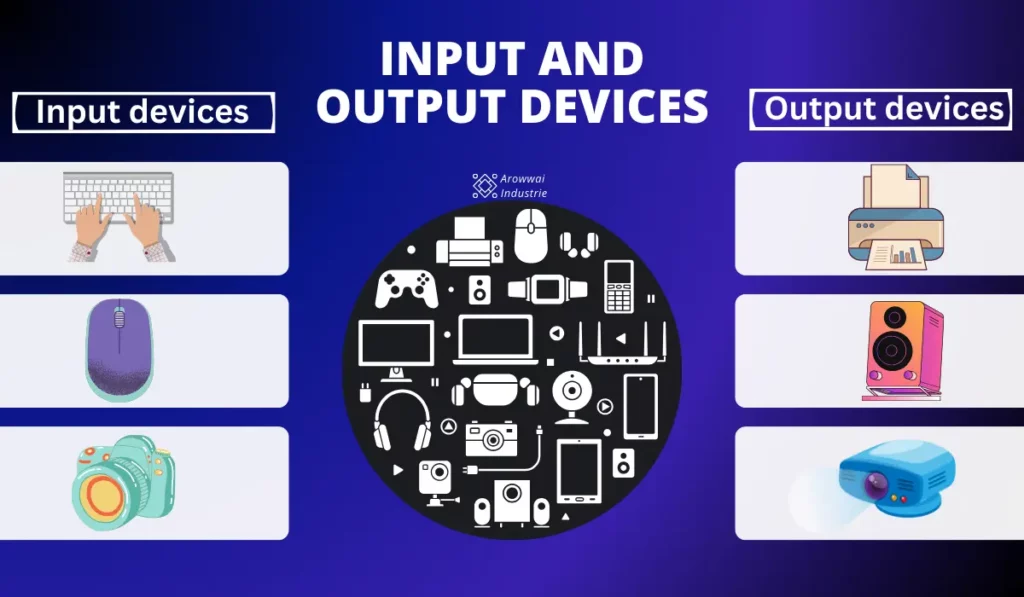
Input and output terms meaning
Let’s first learn what input and output mean:
- The data that the computer receives is input.
- The data that the computer sends is output.
Working principle:
The functioning of a computer system is based on the combined usage of both input and output devices. By using an input device we can send instructions to the computer to perform an action and the device responds to our action with the help of an output device.
How does the input and output device work together?
An input device is something you connect to a computer where you can send information or commands to the computer. An output device is something that we connect to a computer to which information is sent.
The computer is the connecting link between the input and output device. A computer program processes the input information. The result is then sent to an output device such as a screen by the computer.
Let’s take some examples to get a good understanding.
Let’s take a DVD player as our first example
- You click ‘play’ on your remote control. Here the remote control is an input device.
- Remote digitises the input and sends this digital information to the DVD player.
- The computer inside the DVD player processes this input info and works out what to do.
- It will thus start to read the DVD.
- The audio/video information from the DVD is then sent to the display screen and the speakers.
- Here the display screen and speakers are the output devices.
Now consider Games consoles as our 2nd example
- While playing any game, you are using a controller where you press a button and give commands to move a character.
- These inputs are digitized and then sent to the computer to be processed.
- The program inside processes the input and sends an output.
- In this case, the character on screen moves as it has been instructed to.
What is actually a device?
A device is a complete piece of physical hardware that is used to support computer functions within a larger system.
The device is responsible for converting general commands from an application or operating system into specific commands that the computer only understands or vice versa.
In simple terms, a device is an equipment that provides one or more computing functions within a computer system. It can provide input to the computer, accept output or do both at a time.
Now let’s understand what are input and output devices.
What is an Input device?
Computers have really come a long way since the 1970s, and we can now input data into them using a variety of easy-to-use devices.
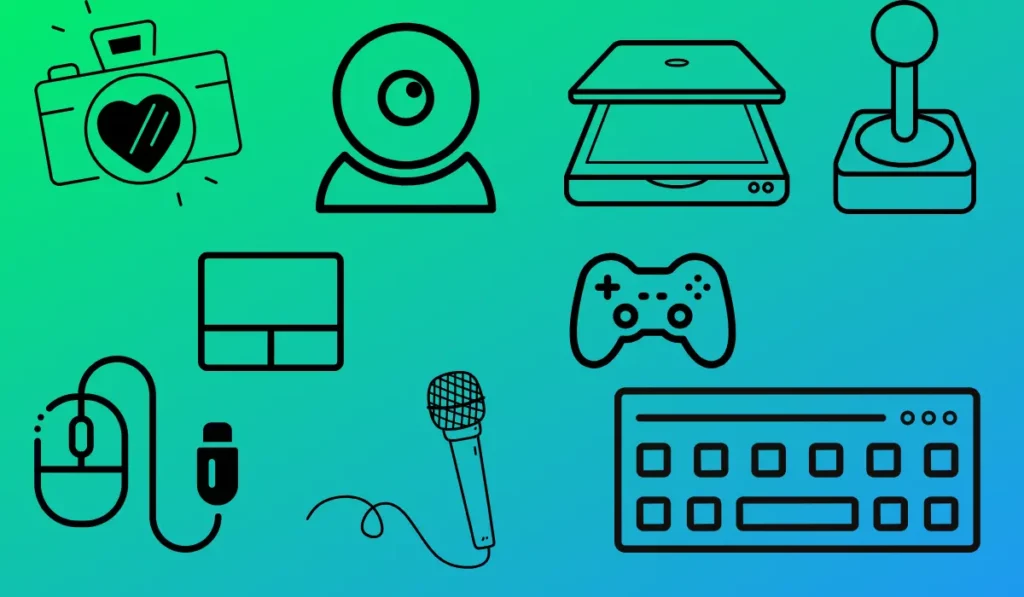
Input devices allow data such as texts, images, videos and sound to be entered into the computer system. These are the devices which write data to a computer and they include a keyboard, mouse, touchpad, joystick, scanner, microphone, barcode scanner, webcam etc.
Examples of the input devices:
- Cameras
- Keyboard
- Joystick
- Barcode reader
- Digital camera
- Gamepad
- Microphone
- MIDI keyboard
- Mouse (pointing device)
- Scanner
- Webcam
- Touchpads
- Pen Input
- MICR (Magnetic Ink character reader)
Need of the Input Devices:
Input devices like keyboards, mice and scanners are required because using these parts we can communicate with the computer. They help us perform tasks like typing, selecting and sending commands to the computer, creating documents, browsing the web and playing games.
Without input devices, we cannot tell our computers what to do and this would hinder our daily digital interactions. They turn our actions into instructions that computers can understand and fill the gap between us and the digital world.
- Cameras:
Cameras are devices using which we can capture moments as pictures or videos. They are like the eyes of a computer. When you take a picture, the camera sees the image and saves it on a memory card. You can then move these pictures to your computer to view, edit, or share with others. - Keyboard:
A keyboard is used to provide input to a computer with human written language. You use it to tell the computer what you want it to do. When you press a key, it sends a message to the computer. Typing e-mails, writing code, playing games, editing videos, or working with Microsoft Office platforms, all these tasks can be done from the keyboard. - Joystick:
It is a tool that helps you play simulation games on your computer. It’s like the steering wheel of a car but for games. When you move it, your game character moves too. It makes playing games fun and easy. - Barcode Reader:
You can consider a barcode reader as a computer’s eyes to read special codes on products. When you go shopping, the cashier scans the barcode to know the price of what you are buying. This scanner reads the lines and spaces in the barcode and tells the computer what item it is. - Digital Camera:
It is a modern camera that saves pictures and videos digitally. Old cameras use film rolls to capture the moments but digital cameras store images on a memory card. You can easily move these digital photos and videos to your computer or share them online. - Gamepad:
A gamepad is your friend for playing games on a computer or a gaming console. It has buttons and sticks that you can press and move to control what happens in the game. - Joystick:
A joystick, like a gamepad, helps you play games. It has a stick that you can move around to control characters or vehicles in games. Some people find joysticks better for flying planes or driving cars in games. - Microphone:
A microphone lets your computer hear your voice. You can use it to talk to friends online, record your voice, or give commands to your computer. - MIDI Keyboard:
A MIDI keyboard is a special kind of keyboard for making music on your computer. Unlike a regular keyboard, a MIDI keyboard makes musical notes. If you love making music, a MIDI keyboard can be your best friend. - Mouse (pointing device):
A mouse helps you point and click on things on your computer screen. It’s your finger for the computer. You can move the mouse around to move the pointer on the screen, and click to open apps, select things, or drag and drop items. - Scanner:
Using the scanner, your computer sees papers and photos. When you put paper on the scanner, it takes a picture of it and sends that picture to your computer. - Webcam:
Using a webcam you can send your pictures and videos live over the internet. You can use a webcam to make video calls to friends and family far away.
What is an Output device?
When we give input to a computer, it processes the input first. Once the CPU (central processing unit) is done processing the data, it gives the result as output.
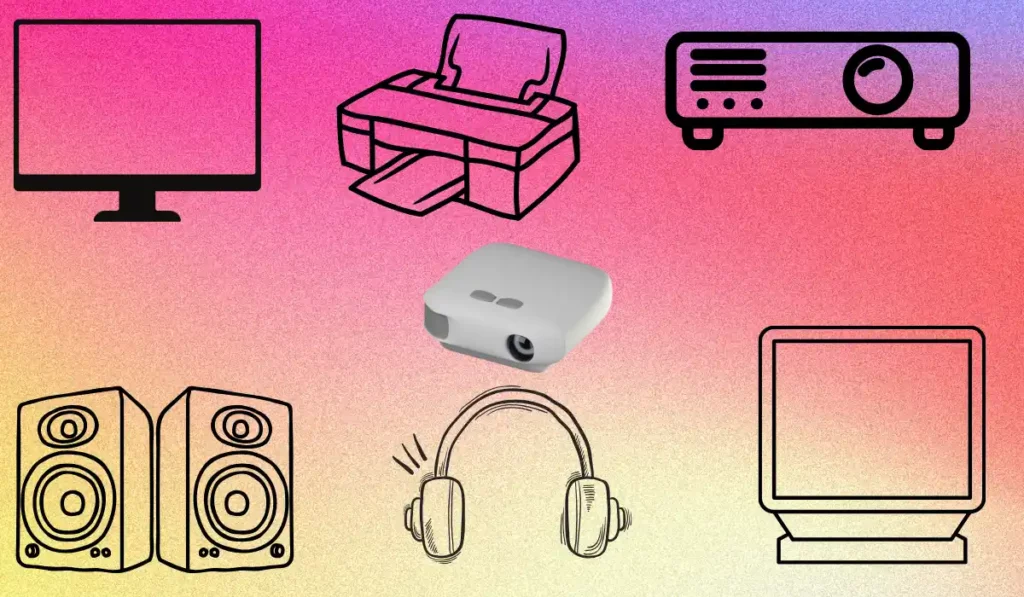
Output devices provide data in varied forms and mostly they are of audio, visual, and hard copy media form. The output devices are often used for displaying and projection. Monitors and printers are two of the very commonly known and used output devices used with a computer.
Examples of the Output devices:
- Monitor (LED, LCD etc)
- Printers (all types)
- Projector
- LCD Projection Panels
- Computer Output Microfilm (COM)
- Speaker(s)
- Head Phone
- Film Recorder
- Microfiche
Discussing the need for the output device:
A computer can still manage to function without an output device. However, without an output device, we won’t be able to know what the computer is doing.
There wouldn’t be any indicator of errors, nor could we know the need for additional input. For example, if I detach my monitor from my computer, the computer will still function, but it’s not going to help me as I couldn’t know anything without seeing the monitor.
Since we have come this far, let’s also get to know in detail about some most widely used output devices.
- Monitor:
This is the most commonly used computer output device. It creates a visual display by the use of which users would be able to view processed data. Monitors come in various resolutions and sizes.- Some common types of monitors:
- Cathode Ray Tube (CRT) – this makes use of the phosphorescent dots in order to generate the pixels that constitute the displayed images.
- Flat Panel Screen (LCD/LED)– this uses plasma or liquid crystals to produce output. Light is passed through the liquid crystals to generate pixels.
- Some common types of monitors:
- Printer:
With the help of this device hard copies of processed data can be generated, like documents and photographs. The computer sends the image data to the printer, which then physically recreates the image on paper.- Types of Printers
- Ink Jet: this kind of printer sprays tiny dots of ink onto a surface to create the image.
- Laser: this type of printer utilizes toner drums that roll through magnetized pigment, and then transfer the pigment to the surface of paper.
- Dot Matrix: these printers utilize the print head to set up images on the surface using an ink ribbon.
- Types of Printers
- Projector:
A projector is a display device that projects a computer-created image/video/presentation onto another surface, which in most cases is a whiteboard or a wall. First image data is transmitted to the video card by computer and then the video image is sent to the projector. - Speakers:
They are attached to computers to facilitate the output of sound. Sound cards are required to be put in the computer for the speakers to function. The various types of speakers range from simple, two-speaker output devices right the way up to surround-sound multi-channel units. - Headset:
A headset is a combo of a speaker and a microphone. Mostly used by gamers and is also a great gadget for communicating with family and friends over social media.
Devices with Both Input–Output functions:
Both input-output devices, as the name suggests, can take in data (input) and provide data (output). They are handy as they serve two purposes in one device.
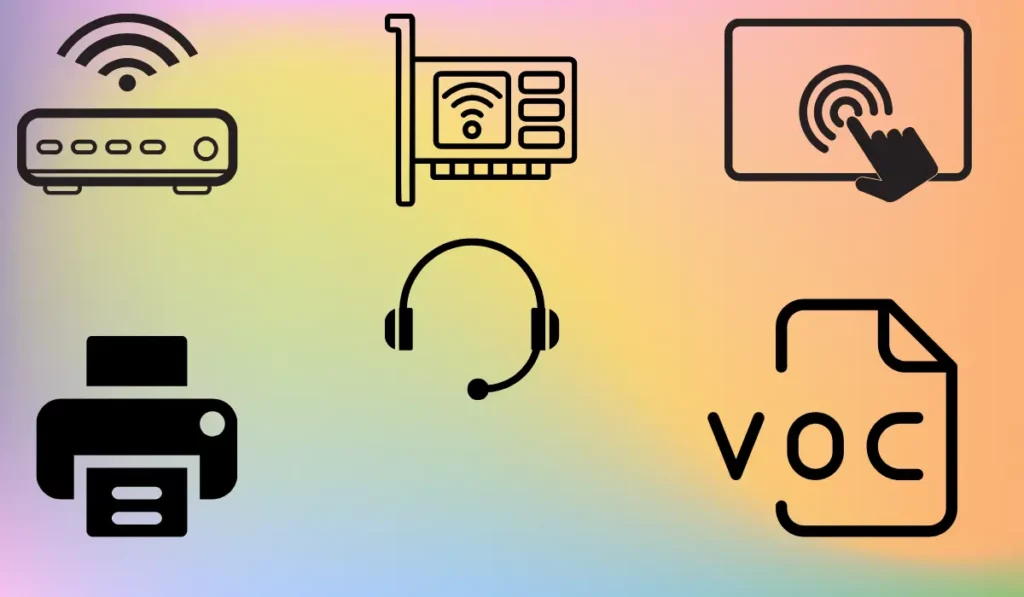
- Modems:
Modems can send data to and receive data from the internet. When you browse the web, the modem sends requests to the internet and receives the web pages as the response. - Network Cards:
Network cards allow your computer to talk to other computers. They can send data and receive data, help in sharing files or accessing shared resources. - Touch Screen:
Touch screens are the most commonly used parts where you can input commands by touching the screen and seeing the output right there on the same screen. - Headsets:
Headsets have a microphone (input) for you to talk and headphones (output) for you to hear sound. - Facsimile (FAX):
Fax machines can scan a document (input) and print a copy of it (output). - Audio Cards / Sound Cards:
These cards can input sound (like your voice) and output sound (like music).
Storage devices:
Storage devices are where you can save your files and data. Once saved, you can come back to them anytime, even after you switch off your computer. You can think of storage devices as your digital cupboards where you keep your digital things. Here are some examples:
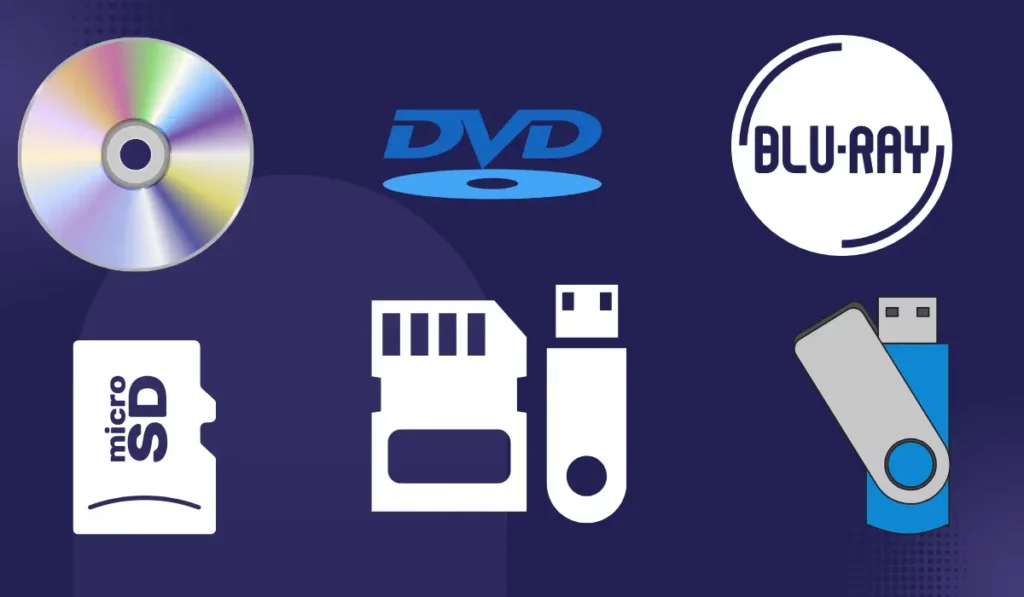
- CDs (Compact Discs):
CDs are small shiny discs where you can save your files. They can hold up to 700 MB of data. You can save music, photos, or any other data on them. - DVDs (Digital Versatile Discs):
DVDs are also shiny discs but can hold more data than CDs, up to 4.7 GB. They are good for saving movies or big files. - Blu-Ray Discs:
Blu-ray discs are also DVDs but their storage capacities are even bigger. They hold up to 25 GB or even 50 GB on dual-layer discs. They are great for high-definition movies or lots of data. - USB Flash Drives:
USB flash drives are small sticks you can carry in your pocket. They plug into your computer’s USB port, and you can save a lot of files on them. They come in many sizes, from a few GBs to many GBs. - SD Cards (Secure Digital Cards):
SD cards are tiny cards that also hold a lot of data. They are commonly used in cameras, phones, and other small gadgets. Similar to USB drives, these cards also come in many sizes and their storage capacity ranges from a few to many GBs of data.
Let’s wrap it up
Input and output devices are the fundamental bridges between us and the digital realm. Input devices like keyboards, mice, and scanners allow us to communicate our instructions to computers. On the flip side, output devices like monitors, speakers, and printers translate the digital language into forms we can perceive.
Both these types of devices work in harmony to make our interaction with computers smooth, meaningful, and productive. They are like the two hands of the computer world, one taking in information and the other giving it out.
In this fast-paced digital landscape, the importance of understanding and appreciating the role of input and output devices cannot be overstated. They are not just tools, but extensions of our capability that enable us to do more, learn more and experience more in the digital world that surrounds us.
Frequently Asked Questions (FAQs)
What are input devices in a computer?
Input devices are tools that let us send information or commands to a computer. They help in interacting with the computer to perform various tasks.
What are examples of input devices?
Examples include keyboards, mice, scanners, microphones, and webcams.
What is an output device in a computer?
Output devices are tools that receive information from the computer and present it to us in a usable form, like visual or auditory.
What are examples of output devices?
Examples include monitors, speakers, printers, and projectors.